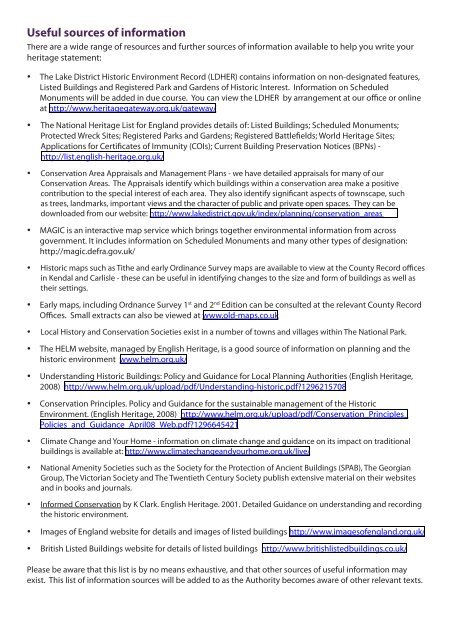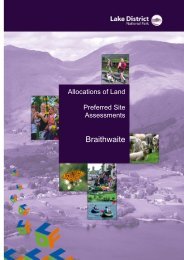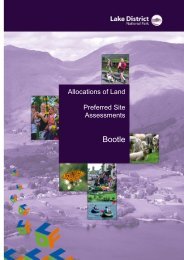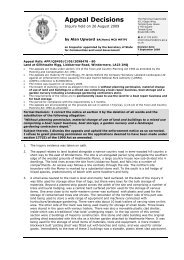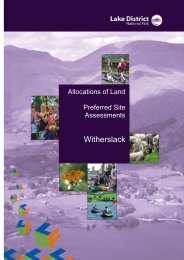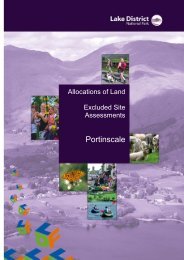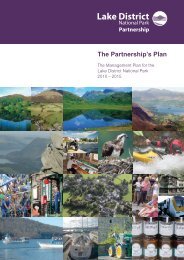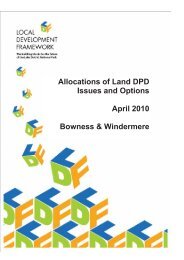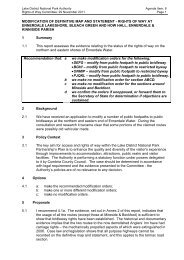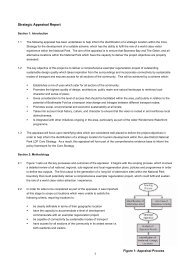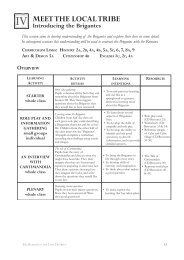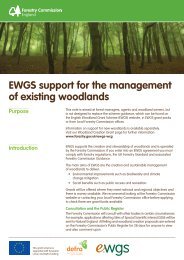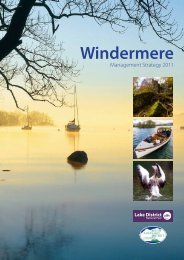Heritage statements guidance note (PDF) - Lake District National Park
Heritage statements guidance note (PDF) - Lake District National Park
Heritage statements guidance note (PDF) - Lake District National Park
Create successful ePaper yourself
Turn your PDF publications into a flip-book with our unique Google optimized e-Paper software.
Useful sources of information<br />
There are a wide range of resources and further sources of information available to help you write your<br />
heritage statement:<br />
• The <strong>Lake</strong> <strong>District</strong> Historic Environment Record (LDHER) contains information on non-designated features,<br />
Listed Buildings and Registered <strong>Park</strong> and Gardens of Historic Interest. Information on Scheduled<br />
at http://www.heritagegateway.org.uk/gateway/<br />
• The <strong>National</strong> <strong>Heritage</strong> List for England provides details of: Listed Buildings; Scheduled Monuments;<br />
http://list.english-heritage.org.uk/<br />
• Conservation Area Appraisals and Management Plans - we have detailed appraisals for many of our<br />
Conservation Areas. The Appraisals identify which buildings within a conservation area make a positive<br />
as trees, landmarks, important views and the character of public and private open spaces. They can be<br />
downloaded from our website: http://www.lakedistrict.gov.uk/index/planning/conservation_areas<br />
• MAGIC is an interactive map service which brings together environmental information from across<br />
government. It includes information on Scheduled Monuments and many other types of designation:<br />
http://magic.defra.gov.uk/<br />
•<br />
in Kendal and Carlisle - these can be useful in identifying changes to the size and form of buildings as well as<br />
their settings.<br />
• Early maps, including Ordnance Survey 1 st and 2 nd Edition can be consulted at the relevant County Record<br />
www.old-maps.co.uk<br />
• Local History and Conservation Societies exist in a number of towns and villages within The <strong>National</strong> <strong>Park</strong>.<br />
• The HELM website, managed by English <strong>Heritage</strong>, is a good source of information on planning and the<br />
historic environment www.helm.org.uk/<br />
• Understanding Historic Buildings: Policy and Guidance for Local Planning Authorities (English <strong>Heritage</strong>,<br />
2008) http://www.helm.org.uk/upload/pdf/Understanding-historic.pdf?1296215708<br />
• Conservation Principles. Policy and Guidance for the sustainable management of the Historic<br />
Environment. (English <strong>Heritage</strong>, 2008) http://www.helm.org.uk/upload/pdf/Conservation_Principles_<br />
Policies_and_Guidance_April08_Web.pdf?1296645421<br />
• Climate Change and Your Home - information on climate change and <strong>guidance</strong> on its impact on traditional<br />
buildings is available at: http://www.climatechangeandyourhome.org.uk/live/<br />
• <strong>National</strong> Amenity Societies such as the Society for the Protection of Ancient Buildings (SPAB), The Georgian<br />
Group, The Victorian Society and The Twentieth Century Society publish extensive material on their websites<br />
and in books and journals.<br />
• Informed Conservation by K Clark. English <strong>Heritage</strong>. 2001. Detailed Guidance on understanding and recording<br />
the historic environment.<br />
• Images of England website for details and images of listed buildings http://www.imagesofengland.org.uk/<br />
• British Listed Buildings website for details of listed buildings http://www.britishlistedbuildings.co.uk/<br />
Please be aware that this list is by no means exhaustive, and that other sources of useful information may<br />
exist. This list of information sources will be added to as the Authority becomes aware of other relevant texts.


